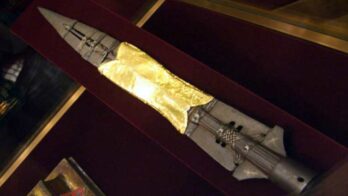OOPARTS (Out-of-Place Artifacts) were discovered in locations or contexts that do not align with what is currently known about history and civilization.
Throughout history, numerous anomalies have been uncovered, including objects that appear modern or made of advanced materials yet were found within ancient layers of earth or other sites where they should not exist.
These artifacts challenge traditional beliefs about the history of human civilization, suggesting that ancient cultures possessed knowledge and technology that was previously thought to be beyond their capabilities.
What Are OOPARTS?
The term “OOPARTS” was first used by Ivan T. Sanderson, a naturalist and cryptozoologist who used it to describe objects of archaeological, historical, or paleontological interest found in anomalous contexts.
While the scientific community rarely uses this term, it has become popular among those who support theories involving ancient aliens, cyclical civilizations, time travel, and parallel universes.
In short, OOPARTS (Out-of-Place-Artifacts) are artifacts that are found in geological strata or other contexts that are inconsistent with the currently accepted historical timeline, suggesting that they may have been created by a culture that predates or is otherwise different from the one that is conventionally thought to have created them.
They are often seen as anomalous or out of place because they challenge conventional scientific or historical understanding.
According to conventional historical views, humans evolved gradually, with truly advanced civilizations emerging only a few thousand years ago.
However, if the Out-of-Place Artifacts are authentic, it would suggest that ancient civilizations possessed advanced knowledge and technology far beyond what was previously thought possible.
Some OOPARTS may even challenge traditional beliefs about the origins and development of human civilization.
Incredible Artifacts Found in Unexpected Places
OOPARTS have led to many questions and debates in the scientific and archaeological communities.
Some explanations have been proposed, including fantastic ones such as vortexes that capture matter and lift it into the air, potentially moving it to another temporal moment before collapsing it into space-time.
According to this theory, these mysterious vortexes can absorb objects from the surface and submerge them into the ground, passing through the earth’s crust as if it doesn’t exist.
Some even believe that matter can become “transparent” under certain conditions, such as lightning or tornadoes, changing its molecular structure and facilitating the phasing through of other matter.
However, many Out-of-Place Artifacts remain unexplained and continue to challenge traditional historical and scientific beliefs.

16 Unbelievable Examples of Out-of-Place Artifacts
Michael Cremo and Richard Thompson’s voluminous work, Forbidden Archeology – The Hidden History of the Human Race, provides the most rigorous collection of scientific data, including an impressive database that shows similar beings to us have existed on Earth for hundreds of millions of years.
Michael Cremo is a member of the Society for the History of Science in the USA, and Richard Thompson is a doctor of mathematics and a member of the World Association of Archaeologists.
The book has been sold in over 200,000 copies and translated into over 20 languages.
The two authors claim that official history needs to be corrected.
To support their claims, MCremo and Thompson included a bunch of examples of OOPARTS (Out-of-Place-Artifacts):
1) The Antikythera mechanism – a complex ancient Greek analog computer discovered in a shipwreck off the coast of Greece in 1901.
2) The Baghdad battery – a set of three artifacts resembling clay jars discovered in Iraq and are believed to date back to the Parthian period (250 BCE to 224 CE).
3) The Coso artifact – a spark plug encased in a geode in California, dated to be 500,000 years old.
4) The Dendera light – a carving in the walls of the Dendera Temple complex in Egypt that some believe depicts an electric light bulb.
5) The Fuente Magna bowl – a large stone bowl discovered in Bolivia that features inscriptions in a language resembling ancient Sumerians.
6) The Grooved Spheres – over 400 stone spheres found in South Africa that are believed to date back to over 3 billion years ago.
7) The Ica stones – a collection of over 15,000 engraved stones uncovered in Peru that depict a range of unusual images, including dinosaurs, advanced technology, and humans coexisting with dinosaurs.
8) The London Hammer – a hammer found embedded in a rock formation in Texas that is believed to be 400 million years old.
9) The Nampa figurine – a small clay figurine found in Idaho that is believed to be between 2 million and 4 million years old.
10) The Tjipetir mystery spheres – rubber balls discovered on beaches in the Netherlands and England in the late 19th and early 20th centuries- remain a mystery regarding their origin and purpose.
11) The famous Piri Reis map from 1513 – depicts South America, the Azores, the Canary Islands, the mythical island of Antillia, and incredible details of Antarctica from before it was covered by ice.
12) The Acambaro figurines – a set of figurines depicting unknown animals.
13) The Dropa Stones – a set of 716 circular stone disks with a groove that spirals to the center, discovered in China in 1938.
14) The Klerksdorp Spheres – metallic spheres that are highly polished and have three parallel grooves around the equator, discovered in South Africa.
15) The Kingoodie Hammer – a hammer found in Scotland embedded in a 400-million-year-old rock.
16) The Maine Penny – a silver coin found in Maine that is believed to date back to the 11th century.
Are OOPARTS Real?
However, many questions remain regarding these artifacts, and there are also suspicions about their authenticity. They are not necessarily all fakes, but their interpretation could be wrong.
For example, there are the Baigong pipes, which have been said to represent a network of metal pipes buried in the rock of Baigong Mountain and are supposedly 150,000 years old.
Some believe that this is proof of the existence of an ancient culture of extraterrestrials.
On the other hand, researchers who had studied them stated that the Baigong pipes are not pipes at all, but rather petrified bamboo wood that made its way into a river basin and later solidified.
Many scientists are attempting to explain these Out-of-Place Artifacts as natural phenomena.
However, others argue that such explanations ignore the vast amount of data that attests to the advanced technological knowledge of prehistoric civilizations, which was lost over the centuries and is only now rediscovered in modern times.
It is important to remain open-minded and continue to study these artifacts to uncover the truth about our ancient history.
At Ancient Theory we only use trusted sources to document our articles. Such relevant sources include authentic documents, newspaper and magazine articles, established authors, or reputable websites.
- Out-of-place artifact. wikipedia.org. [Source]
- Benjamin B. Olshin - Lost Knowledge: The Concept of Vanished Technologies and Other Human Histories. Brill, 2019.
- Stacy Conradt - The Quick 8: Eight Out-of-Place Artifacts.
- Jamie Frater - Top 10 Out-Of-Place Artefacts.
- Oopart - Out of Place Artifacts. medium.com.






